Current Research and Development Status of Corrosion Behavior of Automotive Materials in Biofuels
Abstract
:1. Introduction
2. Methods to Find Corrosion
2.1. Immersion Test Method
- W = weight loss (g);
- D = density (g/cm3);
- A = cross sectional area (cm2);
- T = time (hours).
2.2. Electro-Chemical Method
3. Reasons and Problems of Corrosion of Materials in Biodiesel
4. Corrosiveness of Biodiesels Obtained from Different Feedstock
4.1. Corrosion Studies on Palm Oil-Based Biodiesel
4.2. Corrosion Studies on Jatropha Oil-Based Biodiesel
4.3. Corrosion Studies on Rapeseed Oil-Based Biodiesel
4.4. Corrosion Studies on Sunflower Oil-Based Biodiesel
4.5. Corrosion Studies on Biodiesel Obtained from Different Feedstocks
5. Corrosion Mechanism of Metals in Biodiesel
Cu2O + CO2 + 1/2O2 → 2CuCO3
CuO + CO2 → CuCO3
2Cu + O2 + 2H2O → 2Cu(OH)2
CuO + H2 → Cu(OH)2
6. Characterization Techniques Used
6.1. Characterization and Products of Corrosion Obtained by Palm Biodiesel
6.2. Characterization and Products of Corrosion Obtained by Rapeseed Biodiesel
6.3. Characterization and Products of Corrosion Obtained by Sunflower Biodiesel
7. Application of Corrosion Inhibitors to Protect Corrosion
8. Future Recommendations
9. Conclusions
- Copper has is most affected materials in biodiesel in terms of corrosion followed by brass-, aluminum- and steel-based alloys, respectively. Additionally, the corrosion phenomena, surface morphology, mechanisms of corrosion and products of corrosion have been presented and it can be concluded that pitting is the most common type of corrosion that occurs from the use of biodiesel.
- Most of the materials produce their respective oxides in biodiesel and because of the presence of free oxygen.
- The immersion test method is a beneficial method for corrosion rate measurement.
- The main reasons of corrosion were the presence of unsaturated fatty acids, free water content, the biodiesel feedstock and condensation water on the surface of materials.
- With corrosion, the biodiesel degrades and hence results in an increased wear rate of the engine parts in contact with the biodiesel. Therefore, it is important to minimize corrosion affects produced by the use of biodiesel in engines.
- Most of the biodiesels have shown increased corrosion of materials when the concentration of biodiesel and duration of immersion or temperature was increased.
Author Contributions
Funding
Institutional Review Board Statement
Informed Consent Statement
Data Availability Statement
Conflicts of Interest
Abbreviations
| CR | Corrosion Rate | Spectroscopy | |
| SS | Stainless Steel | WSOB | Waste Sunflower Oil Biodiesel |
| Mg | Magnesium | FTIR | Fourier Transform Infrared |
| MS | Mild Steel | EDS | Energy Dispersive Spectroscopy |
| SEM | Scanning Electron Microscope | RT | Room Temperature |
| XRD | X-Ray Diffraction | HT | High Temperature |
| TAN | Total Acid Number | Cu | Copper |
| OM | Optical Microscope | BS | Brass |
| XPS | X-ray Photoelectron Spectroscopy | Al | Aluminum |
| Spectroscopy | CI | Cast Iron | |
| AAS | Atomic Absorption Spectroscopy | MCS | Mild Carbon Steel |
References
- Aquino, I.P.; Hernandez, R.P.B.; Chicoma, D.L.; Pinto, H.P.F.; Aoki, I.V. Influence of light, temperature and metallic ions on biodiesel degradation and corrosiveness to copper and brass. Fuel 2012, 102, 795–807. [Google Scholar] [CrossRef]
- McCormick, R.; Ratcliff, M.; Moens, L.; Lawrence, R. Several factors affecting the stability of biodiesel in standard accelerated tests. Fuel Process. Technol. 2007, 88, 651–657. [Google Scholar] [CrossRef]
- Sadrolhosseini, A.R.; Moksin, M.M.; Yunus, W.M.M.; Talib, Z.A.; Abdi, M.M. Surface plasmon resonance detection of copper corrosion in biodiesel using polypyrrole-chitosan layer sensor. Opt. Rev. 2011, 18, 331–337. [Google Scholar] [CrossRef] [Green Version]
- Ononiwu, I.; Adams, F.V.; Joseph, I.; Afolabi, A.S. Corrosion behaviour of mild steel in biodiesel prepared from ghee butter. In Proceedings of the World Congress on Engineering, London, UK, 1–3 July 2015. [Google Scholar]
- Kralova, I.; Sjöblom, J. Biofuels–renewable energy sources: A review. J. Dispers. Sci. Technol. 2010, 31, 409–425. [Google Scholar] [CrossRef]
- Kansedo, J.; Lee, K.T.; Bhatia, S. Biodiesel production from palm oil via heterogeneous transesterification. Biomass Bioenergy 2009, 33, 271–276. [Google Scholar] [CrossRef]
- Antolın, G.; Tinaut, F.V.; Briceño, Y.; Castaño, V.; Pérez, C.; Ramírez, A.I. Optimisation of biodiesel production by sunflower oil transesterification. Bioresour. Technol. 2002, 83, 111–114. [Google Scholar] [CrossRef]
- Qiu, F.; Li, Y.; Yang, D.; Li, X.; Sun, P. Biodiesel production from mixed soybean oil and rapeseed oil. Appl. Energy 2011, 88, 2050–2055. [Google Scholar] [CrossRef]
- Issariyakul, T.; Kulkarni, M.G.; Meher, L.C.; Dalai, A.K.; Bakhshi, N.N. Biodiesel production from mixtures of canola oil and used cooking oil. Chem. Eng. J. 2008, 140, 77–85. [Google Scholar] [CrossRef]
- Du, W.; Xu, Y.; Liu, D.; Zeng, J. Comparative study on lipase-catalyzed transformation of soybean oil for biodiesel production with different acyl acceptors. J. Mol. Catal. B Enzym. 2004, 30, 125–129. [Google Scholar] [CrossRef]
- Veljković, V.B.; Biberdžić, M.O.; Banković-Ilić, I.B.; Djalović, I.G.; Tasić, M.B.; Nježić, Z.B.; Stamenković, O.S. Biodiesel production from corn oil: A review. Renew. Sustain. Energy Rev. 2018, 91, 531–548. [Google Scholar] [CrossRef]
- Gürü, M.; Koca, A.; Özer, C.; Çınar, C.; Şahin, F. Biodiesel production from waste chicken fat based sources and evaluation with Mg based additive in a diesel engine. Renew. Energy 2010, 35, 637–643. [Google Scholar] [CrossRef]
- Meher, L.; Sagar, D.V.; Naik, S. Technical aspects of biodiesel production by transesterification—A review. Renew. Sustain. Energy Rev. 2006, 10, 248–268. [Google Scholar] [CrossRef]
- Sheehan, J.; Camobreco, V.; Duffield, J.; Graboski, M.; Shapouri, H. An Overview of Biodiesel and Petroleum Diesel Life Cycles; National Renewable Energy Lab. (NREL): Golden, CO, USA, 1998. [Google Scholar]
- Knothe, G. Dependence of biodiesel fuel properties on the structure of fatty acid alkyl esters. Fuel Process. Technol. 2005, 86, 1059–1070. [Google Scholar] [CrossRef]
- Espinosa, N.; Hösel, M.; Angmo, D.; Krebs, F.C. Solar cells with one-day energy payback for the factories of the future. Energy Environ. Sci. 2011, 5, 5117–5132. [Google Scholar] [CrossRef]
- Kannan, N.; Vakeesan, D. Solar energy for future world: A review. Renew. Sustain. Energy Rev. 2016, 62, 1092–1105. [Google Scholar] [CrossRef]
- Höök, M.; Tang, X. Depletion of fossil fuels and anthropogenic climate change—A review. Energy Policy 2013, 52, 797–809. [Google Scholar] [CrossRef] [Green Version]
- Demirbaş, A. Bioenergy, Global Warming, and Environmental Impacts. Energy Sources 2004, 26, 225–236. [Google Scholar] [CrossRef]
- McGlade, C.; Ekins, P. The geographical distribution of fossil fuels unused when limiting global warming to 2 °C. Nat. Cell Biol. 2015, 517, 187–190. [Google Scholar] [CrossRef] [PubMed]
- Jaichandar, S.; Annamalai, K. The status of biodiesel as an alternative fuel for diesel engine—An Overview. J. Sustain. Energy Environ. 2011, 2, 71–75. [Google Scholar]
- Klass, D.L. A critical assessment of renewable energy usage in the USA. Energy Policy 2003, 31, 353–367. [Google Scholar] [CrossRef]
- Bowman, M.; Hilligoss, D.; Rasmussen, S.; Thomas, R. Biodiesel: A renewable and biodegradable fuel. Hydrocarb. Process. 2006, 85, 103. [Google Scholar]
- Chen, K.-S.; Lin, Y.-C.; Hsieh, L.-T.; Lin, L.-F.; Wu, C.-C. Saving energy and reducing pollution by use of emulsified palm-biodiesel blends with bio-solution additive. Energy 2010, 35, 2043–2048. [Google Scholar] [CrossRef]
- Clark, S.J.; Wagner, L.; Schrock, M.D.; Piennaar, P.G. Methyl and ethyl soybean esters as renewable fuels for diesel engines. J. Am. Oil Chem. Soc. 1984, 61, 1632–1638. [Google Scholar] [CrossRef]
- Tian, Y.; Zhao, L.; Meng, H.; Sun, L.; Yan, J. Estimation of un-used land potential for biofuels development in (the) People’s Republic of China. Appl. Energy 2009, 86, S77–S85. [Google Scholar] [CrossRef]
- Yan, J.; Alvfors, P.; Eidensten, L.; Svedberg, G. A future for biomass. Mech. Eng. 1997, 119, 94. [Google Scholar]
- Ghobadian, B.; Rahimi, H.; Nikbakht, A.; Najafi, G.; Yusaf, T. Diesel engine performance and exhaust emission analysis using waste cooking biodiesel fuel with an artificial neural network. Renew. Energy 2009, 34, 976–982. [Google Scholar] [CrossRef] [Green Version]
- Ramírez-Verduzco, L.F.; Rodríguez-Rodríguez, J.E.; Jaramillo-Jacob, A.D.R. Predicting cetane number, kinematic viscosity, density and higher heating value of biodiesel from its fatty acid methyl ester composition. Fuel 2012, 91, 102–111. [Google Scholar] [CrossRef]
- Gülüm, M.; Bilgin, A. Density, flash point and heating value variations of corn oil biodiesel–diesel fuel blends. Fuel Process. Technol. 2015, 134, 456–464. [Google Scholar] [CrossRef]
- An, H.; Yang, W.; Chou, S.; Chua, K. Combustion and emissions characteristics of diesel engine fueled by biodiesel at partial load conditions. Appl. Energy 2012, 99, 363–371. [Google Scholar] [CrossRef]
- Muñoz, M.; Moreno, F.; Monné, C.; Morea, J.; Terradillos, J. Biodiesel improves lubricity of new low sulphur diesel fuels. Renew. Energy 2011, 36, 2918–2924. [Google Scholar] [CrossRef]
- Fazal, M.; Haseeb, A.; Masjuki, H. Comparative corrosive characteristics of petroleum diesel and palm biodiesel for automotive materials. Fuel Process. Technol. 2010, 91, 1308–1315. [Google Scholar] [CrossRef]
- Popovicheva, O.; Engling, G.; Lin, K.-T.; Persiantseva, N.; Timofeev, M.; Kireeva, E.D.; Völk, P.; Hubert, A.; Wachtmeister, G. Diesel/biofuel exhaust particles from modern internal combustion engines: Microstructure, composition, and hygroscopicity. Fuel 2015, 157, 232–239. [Google Scholar] [CrossRef]
- Ghazali, W.N.M.W.; Mamat, R.; Masjuki, H.; Najafi, G. Effects of biodiesel from different feedstocks on engine performance and emissions: A review. Renew. Sustain. Energy Rev. 2015, 51, 585–602. [Google Scholar] [CrossRef] [Green Version]
- Rakopoulos, C.; Rakopoulos, D.; Hountalas, D.; Giakoumis, E.; Andritsakis, E. Performance and emissions of bus engine using blends of diesel fuel with bio-diesel of sunflower or cottonseed oils derived from Greek feedstock. Fuel 2008, 87, 147–157. [Google Scholar] [CrossRef]
- Haseeb, A.; Sia, S.; Fazal, M.; Masjuki, H. Effect of temperature on tribological properties of palm biodiesel. Energy 2010, 35, 1460–1464. [Google Scholar] [CrossRef]
- Rashid, U.; Anwar, F.; Moser, B.R.; Knothe, G. Moringa oleifera oil: A possible source of biodiesel. Bioresour. Technol. 2008, 99, 8175–8179. [Google Scholar] [CrossRef]
- Demirbas, A. Progress and recent trends in biofuels. Prog. Energy Combust. Sci. 2007, 33, 1–18. [Google Scholar] [CrossRef]
- Goldemberg, J.; Guardabassi, P. Are biofuels a feasible option? Energy Policy 2009, 37, 10–14. [Google Scholar] [CrossRef]
- Dharma, S.; Silitonga, A.; Shamsuddin, A.; Sebayang, A.H.; Milano, J.; Sebayang, R.; Sarjianto; Ibrahim, H.; Bahri, N.; Ginting, B.; et al. Properties and corrosion behaviors of mild steel in biodiesel-diesel blends. Energy Sources Part A Recover. Util. Environ. Eff. 2019, 1–13. [Google Scholar] [CrossRef]
- Thangavelu, S.K.; Chelladorai, P.; Ani, F.N. Corrosion Behaviour of Carbon Steel in Biodiesel–Diesel–Ethanol (BDE) Fuel Blend. In Proceedings of the MATEC Web of Conferences, 2015 4th International Conference on Engineering and Innovative Materials (ICEIM 2015) EDP Sciences, Penang, Malaysia, 20 October 2015. [Google Scholar]
- Canakci, M.; Ozsezen, A.N.; Arcaklioglu, E.; Erdil, A. Prediction of performance and exhaust emissions of a diesel engine fueled with biodiesel produced from waste frying palm oil. Expert Syst. Appl. 2009, 36, 9268–9280. [Google Scholar] [CrossRef]
- Canakci, M.; Van Gerpen, J.H. Comparison of engine performance and emissions for petroleum diesel fuel, yellow grease biodiesel, and soybean oil biodiesel. Trans. ASAE 2003, 46, 937. [Google Scholar] [CrossRef]
- Labeckas, G.; Slavinskas, S. The effect of rapeseed oil methyl ester on direct injection Diesel engine performance and exhaust emissions. Energy Convers. Manag. 2006, 47, 1954–1967. [Google Scholar] [CrossRef]
- Kalligeros, S.; Zannikos, F.; Stournas, S.; Lois, E.; Anastopoulos, G.; Teas, C.; Sakellaropoulos, F. An investigation of using biodiesel/marine diesel blends on the performance of a stationary diesel engine. Biomass Bioenergy 2003, 24, 141–149. [Google Scholar] [CrossRef]
- Dorado, M. Exhaust emissions from a Diesel engine fueled with transesterified waste olive oil⋆. Fuel 2003, 82, 1311–1315. [Google Scholar] [CrossRef]
- Valente, O.S.; Da Silva, M.J.; Pasa, V.M.D.; Belchior, C.R.P.; Sodré, J.R. Fuel consumption and emissions from a diesel power generator fuelled with castor oil and soybean biodiesel. Fuel 2010, 89, 3637–3642. [Google Scholar] [CrossRef]
- Pramanik, K. Properties and use of jatropha curcas oil and diesel fuel blends in compression ignition engine. Renew. Energy 2003, 28, 239–248. [Google Scholar] [CrossRef]
- Sureshkumar, K.; Velraj, R.; Ganesan, R. Performance and exhaust emission characteristics of a CI engine fueled with Pongamia pinnata methyl ester (PPME) and its blends with diesel. Renew. Energy 2008, 33, 2294–2302. [Google Scholar] [CrossRef]
- Nabi, M.N.; Hoque, S.N. Biodiesel production from linseed oil and performance study of a diesel engine with diesel bio-diesel. J. Mech. Eng. 2008, 39, 40–44. [Google Scholar] [CrossRef] [Green Version]
- Holser, R.A.; Harry-O’Kuru, R. Transesterified milkweed (Asclepias) seed oil as a biodiesel fuel. Fuel 2006, 85, 2106–2110. [Google Scholar] [CrossRef]
- Haseeb, A.; Fazal, M.; Jahirul, M.; Masjuki, H. Compatibility of automotive materials in biodiesel: A review. Fuel 2011, 90, 922–931. [Google Scholar] [CrossRef]
- Van Wechem, G.; Beunk, G.; Van Den Elst, F.; Van Der Ploeg, A. Combustion engine with fuel injection system, and a spray valve for such an engine. U.S. Patent 4898142A, 6 February 1990. [Google Scholar]
- Haseeb, A.S.M.A.; Masjuki, H.H.; Ann, L.J.; Fazal, M.A. Corrosion characteristics of copper and leaded bronze in palm biodiesel. Fuel Process. Technol. 2010, 91, 329–334. [Google Scholar] [CrossRef]
- Arslan, R. Emission characteristics of a diesel engine using waste cooking oil as biodiesel fuel. Afr. J. Biotechnol. 2011, 10, 3790–3794. [Google Scholar]
- Cheng, S.; Lloyd, I.K.; Kahn, M. Modification of Surface Texture by Grinding and Polishing Lead Zirconate Titanate Ceramics. J. Am. Ceram. Soc. 1992, 75, 2293–2296. [Google Scholar] [CrossRef]
- Kagwade, S.V.; Clayton, C.R.; Chidambaram, D.; Du, M.L.; Chiang, F.P. The Influence of Acetone Degreasing on the Corrosion Behavior of AA2024-T3. J. Electrochem. Soc. 2000, 147, 4125–4130. [Google Scholar] [CrossRef]
- Internasional, A. ASTM G31-72: Standard Practice for Laboratory Immersion Corrosion Testing of Metals. United State. 2004. Available online: https://www.astm.org/DATABASE.CART/HISTORICAL/G31-72R04.htm (accessed on 3 March 2021).
- Ahn, S.; Choi, Y.; Kim, J.; Han, J. A study on corrosion resistance characteristics of PVD Cr-N coated steels by electrochemical method. Surf. Coat. Technol. 2002, 150, 319–326. [Google Scholar] [CrossRef]
- Cabeza, L.F.; Roca, J.; Noguès, M.; Mehling, H.; Hiebler, S. Immersion corrosion tests on metal-salt hydrate pairs used for latent heat storage in the 48 to 58 °C temperature range. Mater. Corros. 2002, 53, 902–907. [Google Scholar] [CrossRef]
- Akhabue, C.; Aisien, F.; Ojo, C. The effect of Jatropha oil biodiesel on the corrosion rates of aluminium and mild carbon steel. Biofuels 2014, 5, 545–550. [Google Scholar] [CrossRef]
- Sterpu, A.-E.; Dumitru, A.I.; Popa, M.-F. Corrosion behavior of steel in biodiesel of different origin. An. Univ. Ovidius Constanta Ser. Chim. 2012, 23, 143–148. [Google Scholar] [CrossRef] [Green Version]
- Fazal, M.; Haseeb, A.; Masjuki, H. Degradation of automotive materials in palm biodiesel. Energy 2012, 40, 76–83. [Google Scholar] [CrossRef]
- Thangavelu, S.K.; Piraiarasi, C.; Ahmed, A.; Ani, F. Corrosion Behavior of Copper in Biodiesel-Diesel-Bioethanol (BDE). Adv. Mater. Res. 2015, 1098, 44–50. [Google Scholar] [CrossRef]
- Jin, D.; Zhou, X.; Wu, P.; Jiang, L.; Ge, H. Corrosion behavior of ASTM 1045 mild steel in palm biodiesel. Renew. Energy 2015, 81, 457–463. [Google Scholar] [CrossRef]
- Fazal, M.; Haseeb, A.; Masjuki, H. Effect of temperature on the corrosion behavior of mild steel upon exposure to palm biodiesel. Energy 2011, 36, 3328–3334. [Google Scholar] [CrossRef]
- Chew, K.; Haseeb, A.; Masjuki, H.; Fazal, M.; Gupta, M. Corrosion of magnesium and aluminum in palm biodiesel: A comparative evaluation. Energy 2013, 57, 478–483. [Google Scholar] [CrossRef]
- Jakeria, M.R.; Fazal, M.A.; Haseeb, A.S.M.A. Effect of corrosion inhibitors on corrosiveness of palm biodiesel. Corros. Eng. Sci. Technol. 2015, 50, 56–62. [Google Scholar] [CrossRef]
- Kaul, S.; Saxena, R.; Kumar, A.; Negi, M.; Bhatnagar, A.; Goyal, H.; Gupta, A. Corrosion behavior of biodiesel from seed oils of Indian origin on diesel engine parts. Fuel Process. Technol. 2007, 88, 303–307. [Google Scholar] [CrossRef]
- Hu, E.; Xu, Y.; Hu, X.; Pan, L.; Jiang, S. Corrosion behaviors of metals in biodiesel from rapeseed oil and methanol. Renew. Energy 2012, 37, 371–378. [Google Scholar] [CrossRef]
- Norouzi, S.; Eslami, F.; Wyszynski, M.L.; Tsolakis, A. Corrosion effects of RME in blends with ULSD on aluminium and copper. Fuel Process. Technol. 2012, 104, 204–210. [Google Scholar] [CrossRef]
- Cursaru, D.; Mihai, S. Corrosion Behaviour of Automotive Materials in Biodiesel from Sunflower Oil. Rev. Chim. 2012, 63, 149–158. [Google Scholar]
- Samuel, O.D.; Gulum, M. Mechanical and corrosion properties of brass exposed to waste sunflower oil biodiesel-diesel fuel blends. Chem. Eng. Commun. 2019, 206, 682–694. [Google Scholar] [CrossRef]
- Cursaru, D.-L.; Brănoiu, G.; Ramadan, I.; Miculescu, F. Degradation of automotive materials upon exposure to sunflower biodiesel. Ind. Crop. Prod. 2014, 54, 149–158. [Google Scholar] [CrossRef]
- Díaz-Ballote, L.; López-Sansores, J.; Maldonado-López, L.; Garfias-Mesias, L. Corrosion behavior of aluminum exposed to a biodiesel. Electrochem. Commun. 2009, 11, 41–44. [Google Scholar] [CrossRef]
- Lu, Q.; Zhang, J.; Zhu, X. Corrosion properties of bio-oil and its emulsions with diesel. Chin. Sci. Bull. 2008, 53, 3726–3734. [Google Scholar] [CrossRef]
- Román, A.S.; Méndez, C.M.; Ares, A.E. Corrosion Resistance of Stainless Steels in Biodiesel. In Shape Casting: 6th International Symposium; Springer: Cham, Switzerland, 2016. [Google Scholar]
- Geller, D.P.; Adams, T.T.; Goodrum, J.W.; Pendergrass, J. Storage stability of poultry fat and diesel fuel mixtures: Specific gravity and viscosity. Fuel 2008, 87, 92–102. [Google Scholar] [CrossRef]
- Aghbashlo, M.; Tabatabaei, M.; Khalife, E.; Najafi, B.; Mirsalim, S.M.; Gharehghani, A.; Mohammadi, P.; Dadak, A.; Shojaei, T.R.; Khounani, Z. A novel emulsion fuel containing aqueous nano cerium oxide additive in diesel–biodiesel blends to improve diesel engines performance and reduce exhaust emissions: Part II—Exergetic analysis. Fuel 2017, 205, 262–271. [Google Scholar] [CrossRef]
- Aghbashlo, M.; Tabatabaei, M.; Mohammadi, P.; Mirzajanzadeh, M.; Ardjmand, M.; Rashidi, A. Effect of an emission-reducing soluble hybrid nanocatalyst in diesel/biodiesel blends on exergetic performance of a DI diesel engine. Renew. Energy 2016, 93, 353–368. [Google Scholar] [CrossRef]
- Aghbashlo, M.; Tabatabaei, M.; Mohammadi, P.; Pourvosoughi, N.; Nikbakht, A.M.; Goli, S.A.H. Improving exergetic and sustainability parameters of a DI diesel engine using polymer waste dissolved in biodiesel as a novel diesel additive. Energy Convers. Manag. 2015, 105, 328–337. [Google Scholar] [CrossRef]
- Aghbashlo, M.; Tabatabaei, M.; Rastegari, H.; Ghaziaskar, H.S. Exergy-based sustainability analysis of acetins synthesis through continuous esterification of glycerol in acetic acid using Amberlyst®36 as catalyst. J. Clean. Prod. 2018, 183, 1265–1275. [Google Scholar] [CrossRef]
- Ahmmad, M.S.; Haji Hassan, M.B.; Kalam, M.A. Comparative corrosion characteristics of automotive materials in Jatropha biodiesel. Int. J. Green Energy 2018, 15, 393–399. [Google Scholar] [CrossRef]
- Aksoy, F. Alkaline catalyzed biodiesel production from safflower (Carthamus tinctorius L.) oil: Optimization of parameters and determination of fuel properties. Energy Sources Part A Recover. Util. Environ. Eff. 2016, 38, 835–841. [Google Scholar] [CrossRef]
- Al-Dawody, M.F.; Bhatti, S. Optimization strategies to reduce the biodiesel NOx effect in diesel engine with experimental verification. Energy Convers. Manag. 2013, 68, 96–104. [Google Scholar] [CrossRef]
- Amaya, A.; Piamba, O.; Olaya, J. Improvement of Corrosion Resistance for Gray Cast Iron in Palm Biodiesel Application Using Thermoreactive Diffusion Niobium Carbide (NbC) Coating. Coatings 2018, 8, 216. [Google Scholar] [CrossRef] [Green Version]
- Amgain, K.; Subedi, B.N.; Joshi, S.; Bhattarai, J. Investigation on the effect of tinospora cordifolia plant extract as a green corrosion inhibitor to aluminum and copper in biodiesel and its blend. In Proceedings of the NIGIS* CORCON 2018, Jaipur, India, 30 September–3 October 2018. Paper No. PP19. [Google Scholar]
- Ashraful, A.; Masjuki, H.; Kalam, M.; Rashedul, H.; Sajjad, H.; Abedin, M. Influence of anti-corrosion additive on the performance, emission and engine component wear characteristics of an IDI diesel engine fueled with palm biodiesel. Energy Convers. Manag. 2014, 87, 48–57. [Google Scholar] [CrossRef]




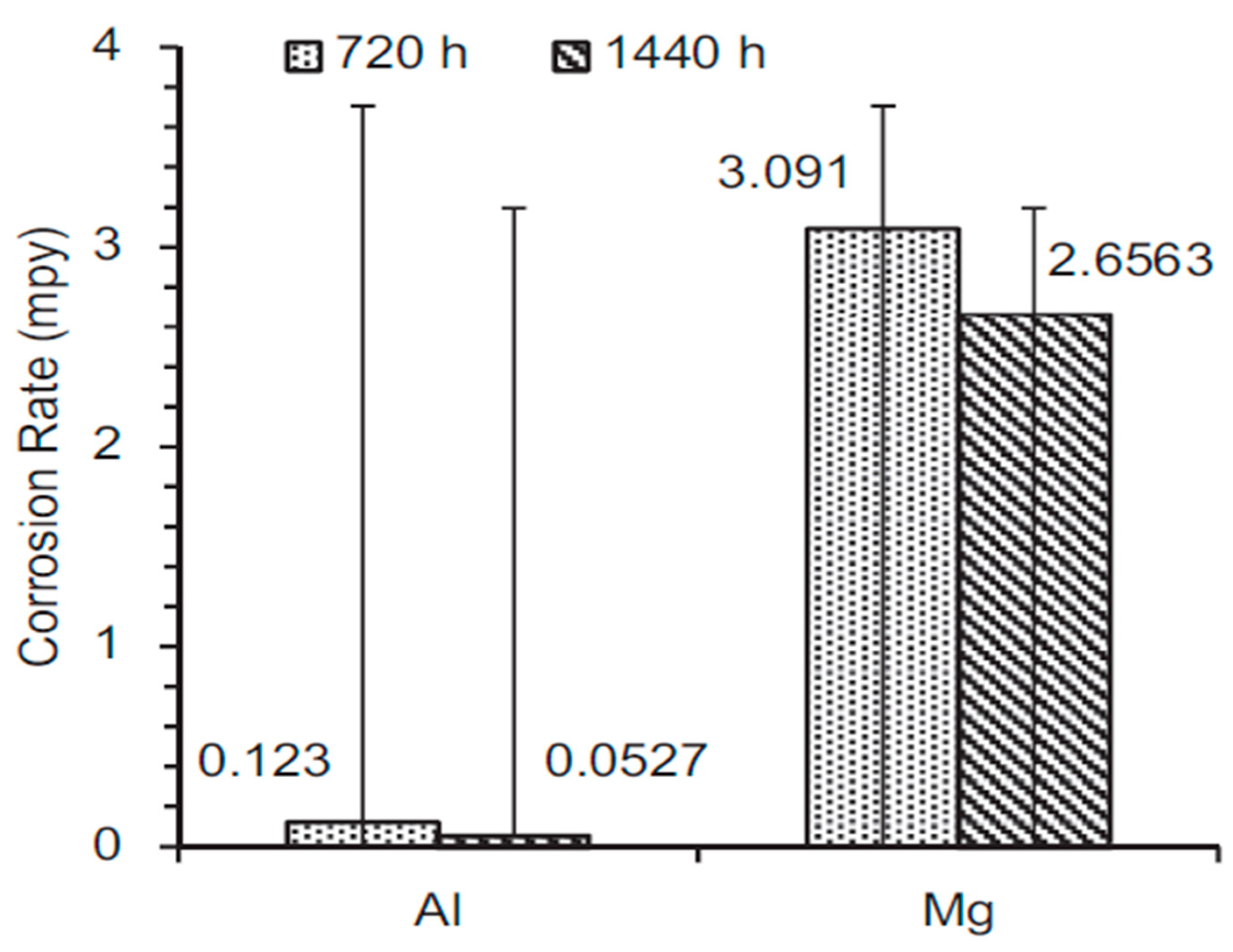



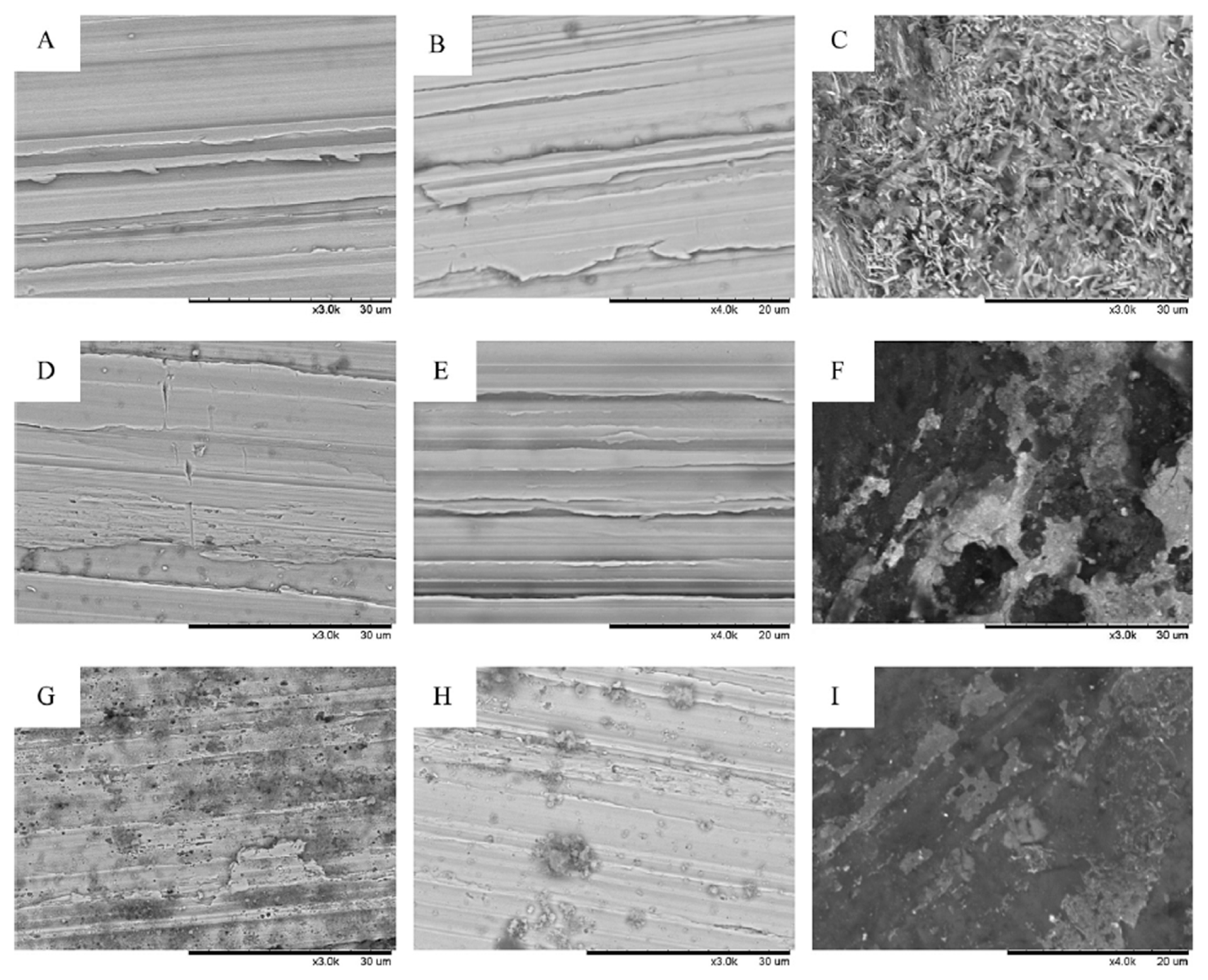

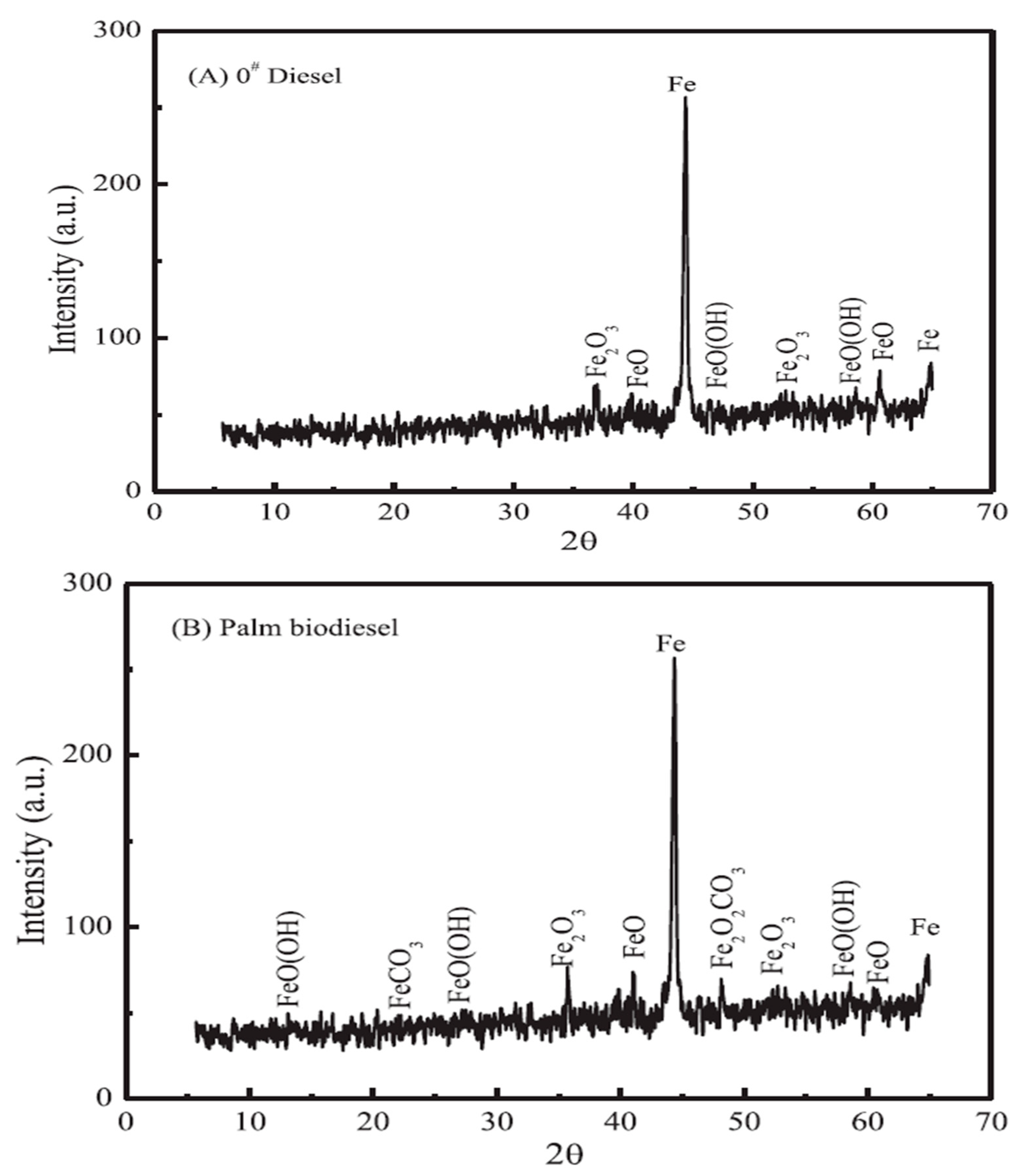

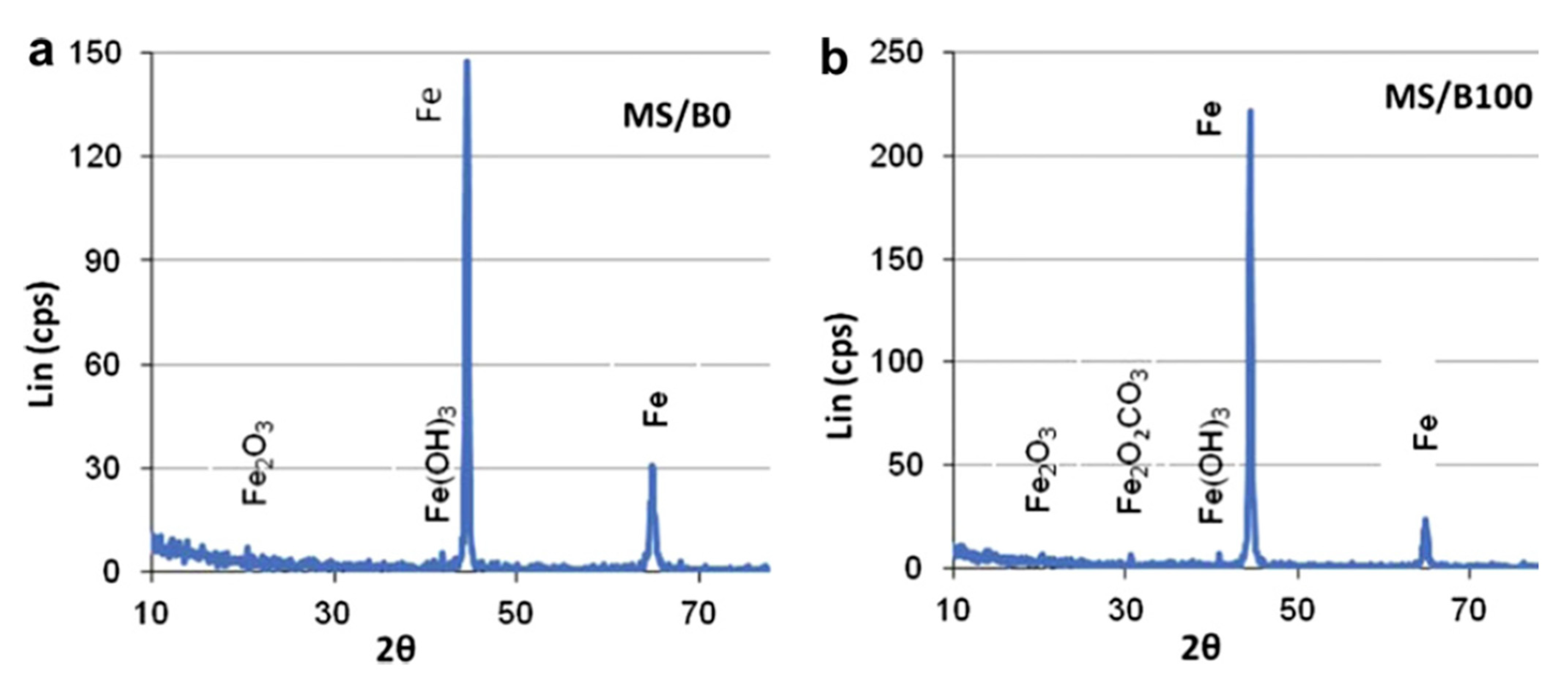





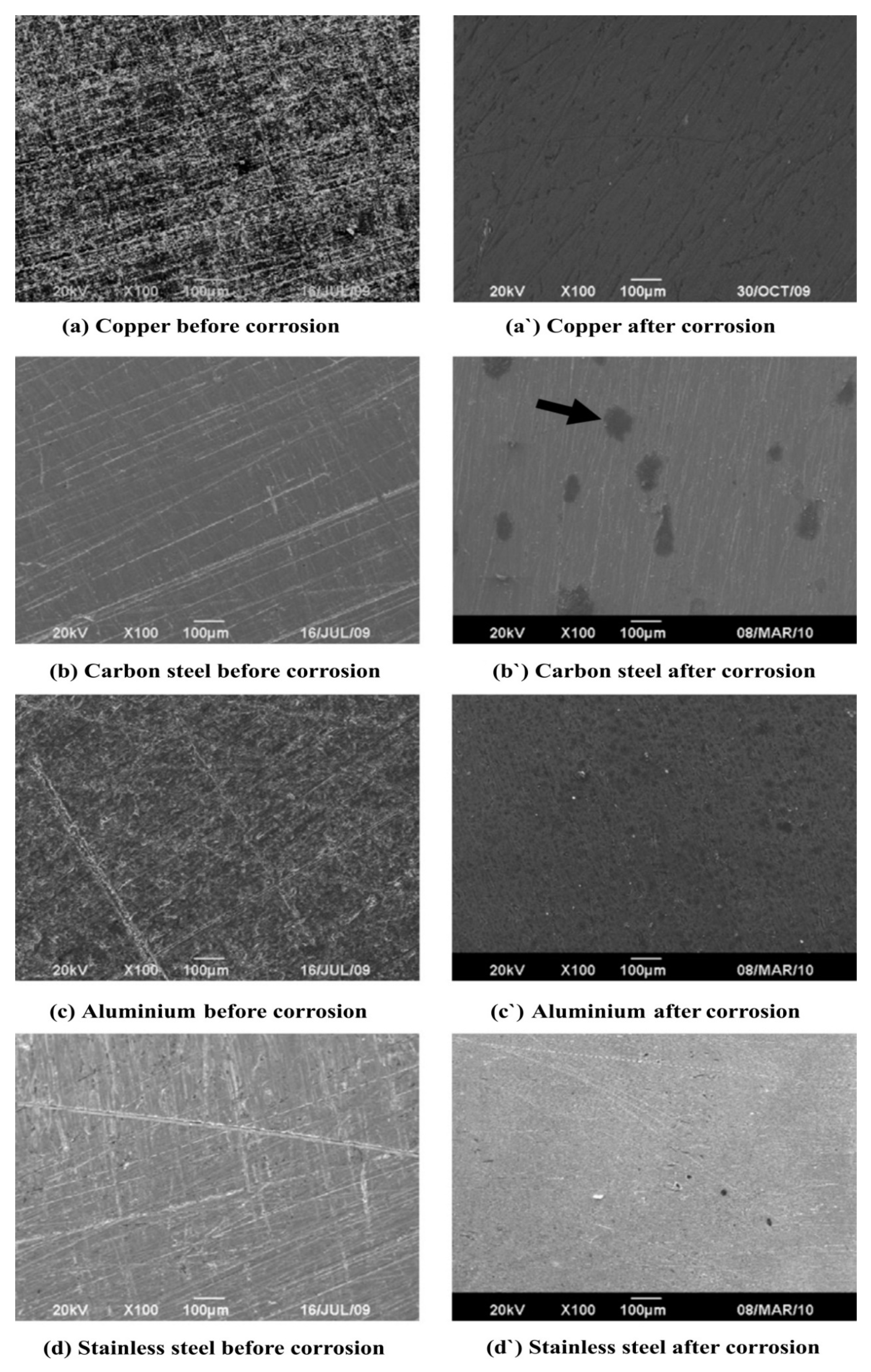
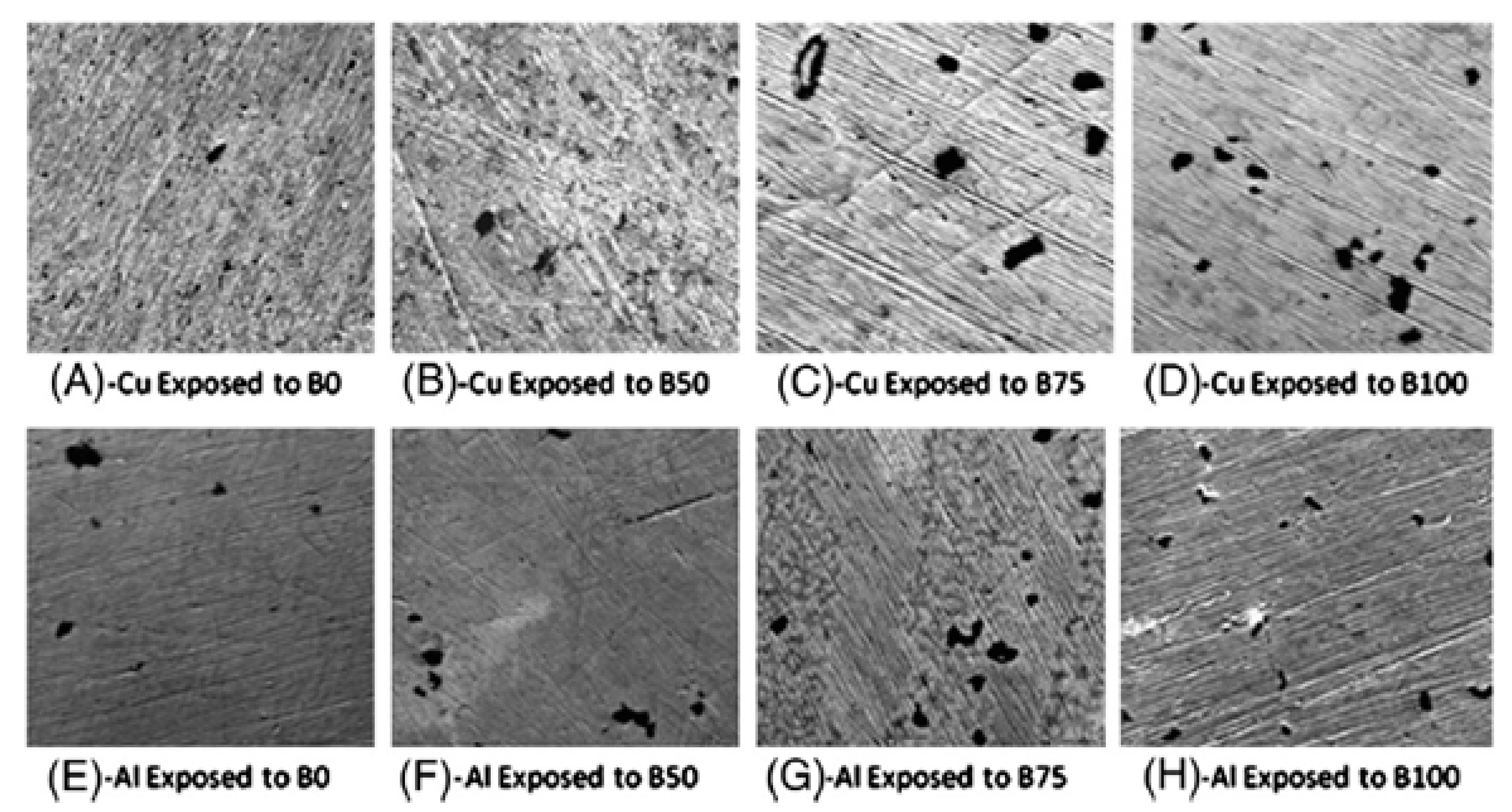
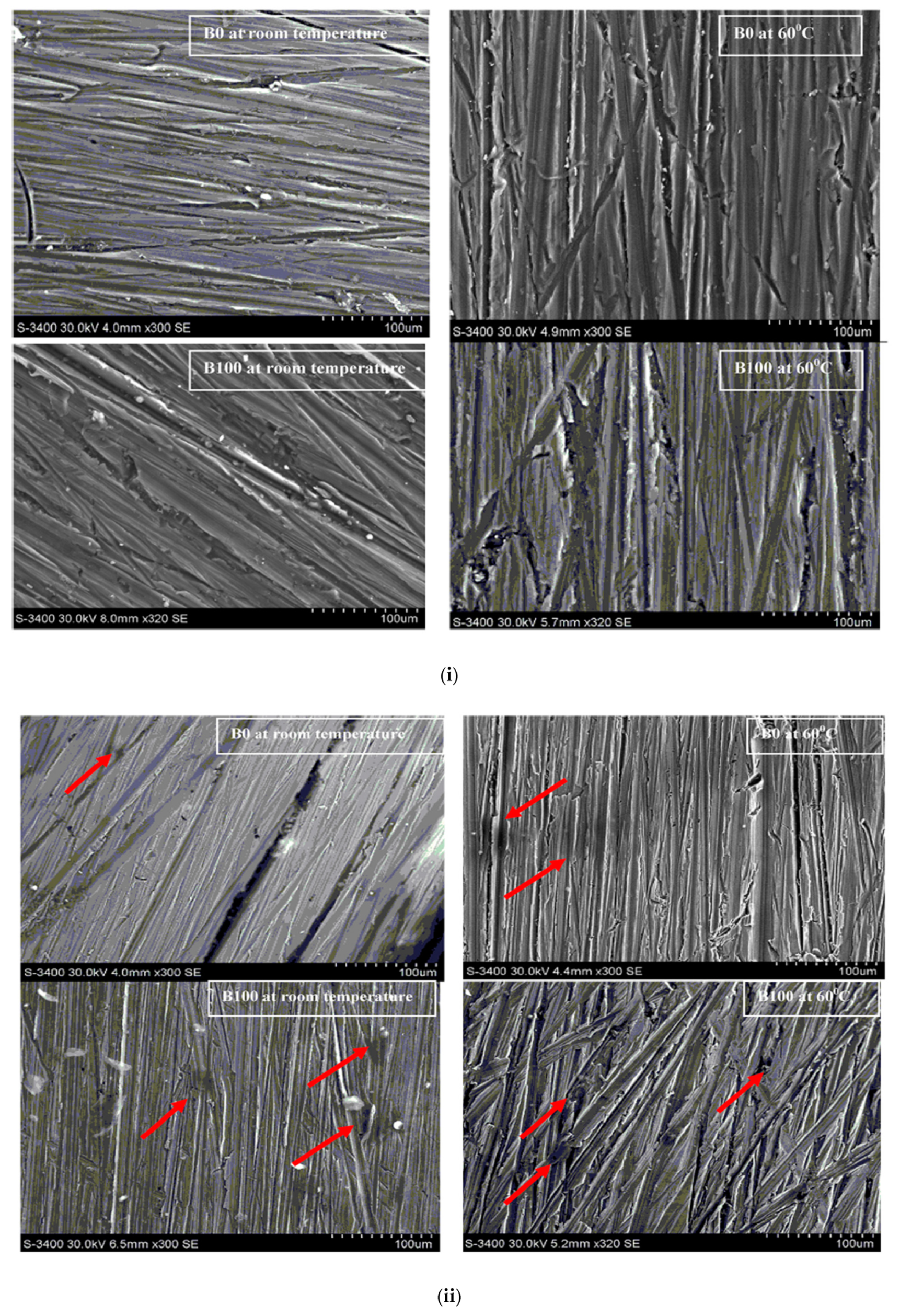

| Sr. No. | Test Type | Material | Biofuel Blends | Temperature | Time | Characterization | TAN (mg KOH/g) | Corrosion Rate |
|---|---|---|---|---|---|---|---|---|
| 1. | Immersion Test | Pure Copper | 45% biodiesel, 35% diesel and 20% bioethanol (B45D35E20) | Room temperature | 408 h | OM, FTIR | Increased at high temperature | 0.277 mpy [65] |
| 50 °C | 0.327 mpy | |||||||
| 2. | Immersion Test | Copper, Leaded Bronze | B0, B50, B100 | Room temperature | 2640 h | TAN analyzer, FTIR, MOA | - | 0.018 mpy (Bronze) and 0.042 mpy (Copper) [55] |
| B0, B100, B100(oxidized) | 60 °C | 840 h | 0.023 mpy (Bronze) and 0.053 mpy (Copper) | |||||
| 3. | Immersion Test | Copper, Brass, Aluminum, Cast Iron | B0, B100 | Room temperature | 2880 h | SEM/EDS, XRD | 0.35 (as-received), 2.57 (Copper), 2.29 (Brass), 1.68 (Aluminum), 1.69 (Cast Iron) | 0.38278 mpy (Copper), 0.209898 mpy (Brass), 0.173055 mpy (Aluminum) and 0.112232 mpy (Cast Iron) [64] |
| 4. | Immersion Test | Copper, Stainless Steel, Aluminum | B0, B100 | 80 °C | 1200 h | OM, SEM, EDS | Increased to limit according to ASTM D6751 | 0.015 mpy (Stainless Steel), 0.202 mpy (Aluminum) and 0.586 mpy (Copper) [33] |
| 5. | Immersion Test | Carbon Steel | B0, B20D70E10 | Room temperature | 800 h 400 h | OM, FTIR | 0.25 (as-received) 1.15 (Room temperature) 1.59 (60 °C) | 0.1817 mpy (B20D70E10) and 0.0523 (B0) [42] |
| 60 °C | 0.2612 mpy (B20D70E10) and 0.115 mpy (B0) | |||||||
| 6. | Immersion Test | Carbon Steel ASTM 1045 | - | 27 °C, 50 °C, 80 °C | 30, 60, 120 days | SEM/EDS, XRD, FTIR | Increased with the increase in temperature and time | With the rise in temperature and exposure time the CRs of Mild Steel increased in both fuels [66] |
| 7. | Immersion Test | Mild Steel | B0, B50, B100 | Room temperature, 50 °C, 80 °C | 1200 h | OM, SEM, EDS, XRD | Increased to limit according to ASTM D6751 | At RT, the CR of MS in biodiesel and diesel was 0.052 mpy and 0.046 mpy, respectively. While at 80 °C the CR was 0.059 mpy and 0.05 mpy, respectively [67] |
| 8. | Immersion Test | Aluminum, Magnesium | B100 | Room temperature | 720 h | SEM/EDS, XRD, FTIR | 0.27 (as-received) 0.92 (Aluminum) 0.87 (Magnesium) | 0.1230 mpy (Aluminum) and 3.0910 mpy (Magnesium) [68] |
| 1440 h | 0.0527 mpy (Aluminum) and 2.6563 mpy (Magnesium) | |||||||
| 9. | Immersion Test | Copper, Mild Steel | - | Room temperature | 60 days | SEM/EDS, AFM | - | CR of Copper was decreased effectively by using Benzotriazole than that of Mild Steel. In the presence of Adenine, the CR of Copper decreased from 0.7495 to 0.2512 mg/cm2 [69] |
| Sr. No. | Test Type | Material | Biofuel Blends | Temperature | Time | Characterization | TAN (mg KOH/g) | Corrosion Rate |
|---|---|---|---|---|---|---|---|---|
| 1. | Immersion Test | Piston metal, Piston liner | B100 | Room temperature | 300 days | - | 0.38 (as-received), 19.54 (piston liner), 14.48 (piston metal) | Salvadora is the most corrosive biodiesel followed by jatropha curcas, mahua and karanja [70] |
| 2. | Immersion Test | Mild Steel | B0, B10, B20, B30, B40, B50 | Room temperature | 400 h, 800 h | SEM | Higher however in range as compared to ASTM D 6751 standards | CRs were higher at 400 h and were 0.0018 (B0), 0.0011 (B10), 0.0198 (B20), 0.0199 (B30), 0.0222 (B40) and 0.0289 (B50) mm/year. For B20, B30 and B50, CRs decreased to 0.01176, 0.01546 and 0.02524 mm/year at 800 h [41] |
| 3. | Immersion Test | Aluminum, Mild Carbon Steel | B0, B50, B100 | Room temperature | 18 weeks (3 weeks interval) | - | 0.41 and 0.52 (as-received B100 and B50), 3.53 and 1.54 (MCS B100 and B50), 2.81 and 1.51 (Al B100 and B50) | The CRs of Aluminum were lower than those of MCS. The CRs of MCS in B0, B50 and B100 were 0.0011, 0.0022 and 0.0026 mpy, respectively. The CRs of Al in B50 and B100 were 0.0099 and 0.016 mpy in the 15th week [62] |
| Sr. No. | Test Type | Material | Biofuel Blends | Temperature | Time | Characterization | TAN (mg KOH/g) | Corrosion Rate |
|---|---|---|---|---|---|---|---|---|
| 1. | Immersion Test | Carbon Steel | - | Room temperature | 1176 h | - | Increased | Corrosion rates in corn, rapeseed and sunflower biodiesels were 0.001164, 0.000760 and 0.000855 mm/year, respectively [63] |
| 2. | Immersion Test | Copper, Aluminum, Stainless Steel, Mild Carbon Steel | B20 | 43 °C | 2 months | SEM/EDS, XPS, AAS | - | The corrosion rates of copper and mild carbon steel were 0.02334 and 0.01819 mm/year in biodiesel while 0.0037 and 0.0015 mm/year for diesel, respectively [71] |
| 3. | Immersion Test | AW 6060 Aluminum alloy, E-Cu57 Copper | B0, B50, B75, B100 | 80 °C | 600 h | SEM/EDS | More than the ASTM D6751 limit of 0.8 | The increase in biodiesel concentration and the temperature increased the corrosion rate of the biodiesel [72] |
| Sr. No. | Test Type | Material | Biofuel Blends | Temperature | Time | Characterization | TAN (mg KOH/g) | Corrosion Rate |
|---|---|---|---|---|---|---|---|---|
| 1. | Immersion Test | Brass | B0, B10, B20, B40 | Room temperature | 240, 480, 720, 960 h | JCM 100 mini SEM | 0.297 (as-received), 0.35 (B0), 0.4 (B10), 0.47 (B20), 0.73 (B40), 1.95 (B100) | Increased duration and biodiesel fraction increased the corrosion rate [73] |
| 2. | Immersion Test | Aluminum, Copper, Mild Carbon Steel | B0, B20, B100 | Room temperature, 60 °C | 3000 h | SEM/EDS, XRD | - | At RT, the CRs of copper, aluminum and mild carbon steel were 0.323615, 0.162201 and 0.170124 mpy, respectively, and at 60 °C, these results were 0.640758, 0.316292 and 0.336845 mpy, respectively [74] |
| 3. | Electrochemical Method | Monel Steel, Stainless Steel, Mild Steel | 1, 5 and 10 percent | 50 °C | 3 h | - | 0.12 (as-received), 0.18 (B1), 0.2 (B5), 0.21 (B10), 0.3 (B100) | The CR of monel steel was 0.000045 mm/year, stainless steel was 0.000421 mm/year and mild carbon steel was 0.000514 mm/year. Corrosion of these materials was lowest in pure diesel than in biodiesel. [75] |
| Sr. No. | Test Type | Biodiesel | Material | Biofuel Blends | Temperature | Time | Characterization | Corrosion Rate/Findings |
|---|---|---|---|---|---|---|---|---|
| 1. | Electrochemical | Canola | Aluminum | - | - | - | - | The corrosion of Aluminum can be used as an indicator to assess the purity of the biodiesel [76] |
| 2. | Immersion Test | Ghee Butter | Mild Steel | - | Room temperature, Different temperatures | - | - | Biodiesel samples were more corrosive than mineral diesel samples. The CR was increased with the increase in the temperature [4] |
| 3. | Immersion Test | Rice Husk | Austenite Stainless Steel, Brass, Mild Steel, Aluminum | B10, B30 | Room temperature, 50 °C, 70 °C | 6, 12, 24, 48, 72, 120 h | XPS | Brass exhibited very slight weight loss, Aluminum exhibited little more than Brass and Mild Steel exhibited more weight loss than both Aluminum and Brass. At elevated temperatures, the weight loss was enhanced for the above-mentioned materials. Stainless Steel did not show any weight loss at any conditions [77] |
| 4. | Electrochemical | Soybean | Duplex 2205, Sea Curve, AISI 304l | - | Room temperature | 20 h | - | The best resistance towards corrosion was shown by Duplex 2205 while Sea Curve steel showed the least corrosion resistance [78] |
| 5. | Immersion Test | Commercial | Copper, Brass | - | 55 °C | 5 days | Raman Vibrational Spectroscopy | The rate of corrosion was slightly higher in the case of incidence light. At higher temperature, corrosion rates have decreased. The CRs for Brass are always more than those of Copper [1] |
| 6. | Immersion Test | Poultry Fat | 316 Stainless Steel, Grey Cast Iron, Copper, Admiralty Brass, Carbon Steel | B20, B80 | 38 °C | 10 months | Digital Photography, photo Microscopy | 316 Stainless Steel and Carbon Steel had no visible corrosion. Copper showed huge corrosiveness in biodiesel. B20 had a slightly lower corrosion rate than that of B80. In the case of Brass, similar trends to that of Copper were observed however these were to a lesser extent [79] |
Publisher’s Note: MDPI stays neutral with regard to jurisdictional claims in published maps and institutional affiliations. |
© 2021 by the authors. Licensee MDPI, Basel, Switzerland. This article is an open access article distributed under the terms and conditions of the Creative Commons Attribution (CC BY) license (http://creativecommons.org/licenses/by/4.0/).
Share and Cite
Shehzad, A.; Ahmed, A.; Quazi, M.M.; Jamshaid, M.; Ashrafur Rahman, S.M.; Hassan, M.H.; Javed, H.M.A. Current Research and Development Status of Corrosion Behavior of Automotive Materials in Biofuels. Energies 2021, 14, 1440. https://doi.org/10.3390/en14051440
Shehzad A, Ahmed A, Quazi MM, Jamshaid M, Ashrafur Rahman SM, Hassan MH, Javed HMA. Current Research and Development Status of Corrosion Behavior of Automotive Materials in Biofuels. Energies. 2021; 14(5):1440. https://doi.org/10.3390/en14051440
Chicago/Turabian StyleShehzad, Aamir, Arslan Ahmed, Moinuddin Mohammed Quazi, Muhammad Jamshaid, S. M. Ashrafur Rahman, Masjuki Haji Hassan, and Hafiz Muhammad Asif Javed. 2021. "Current Research and Development Status of Corrosion Behavior of Automotive Materials in Biofuels" Energies 14, no. 5: 1440. https://doi.org/10.3390/en14051440






